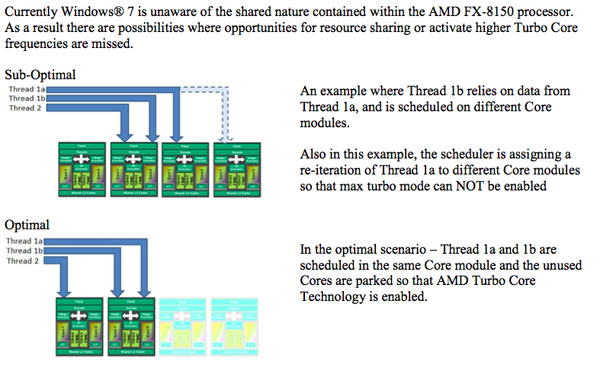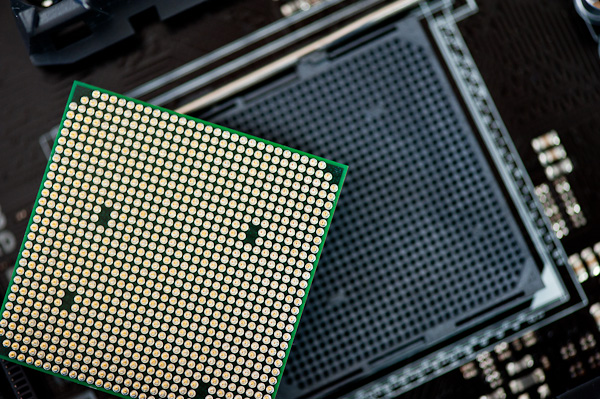The Bulldozer Review: AMD FX-8150 Tested
by Anand Lal Shimpi on October 12, 2011 1:27 AM ESTFinal Words
In many cases, AMD's FX-8150 is able to close the gap between the Phenom II X6 and Intel's Core i5 2500K. Given the right workload, Bulldozer is actually able to hang with Intel's fastest Sandy Bridge parts. We finally have a high-end AMD CPU with power gating as well as a very functional Turbo Core mode. Unfortunately the same complaints we've had about AMD's processors over the past few years still apply here today: in lightly threaded scenarios, Bulldozer simply does not perform. To make matters worse, in some heavily threaded applications the improvement over the previous generation Phenom II X6 simply isn't enough to justify an upgrade for existing AM3+ platform owners. AMD has released a part that is generally more competitive than its predecessor, but not consistently so. AMD also makes you choose between good single or good multithreaded performance, a tradeoff that we honestly shouldn't have to make in the era of power gating and turbo cores.
Bulldozer is an interesting architecture for sure, but I'm not sure it's quite ready for prime time. AMD clearly needed higher clocks to really make Bulldozer shine and for whatever reason it was unable to attain that. With Piledriver due out next year, boasting at least 10-15% performance gains at the core level it seems to me that AMD plans to aggressively address the shortcomings of this architecture. My only concern is whether or not a 15% improvement at the core level will be enough to close some of the gaps we've seen here today. Single threaded performance is my biggest concern, and compared to Sandy Bridge there's a good 40-50% advantage the i5 2500K enjoys over the FX-8150. My hope is that future derivatives of the FX processor (perhaps based on Piledriver) will boast much more aggressive Turbo Core frequencies, which would do wonders at eating into that advantage.

AMD also shared with us that Windows 7 isn't really all that optimized for Bulldozer. Given AMD's unique multi-core module architecture, the OS scheduler needs to know when to place threads on a single module (with shared caches) vs. on separate modules with dedicated caches. Windows 7's scheduler isn't aware of Bulldozer's architecture and as a result sort of places threads wherever it sees fit, regardless of optimal placement. Windows 8 is expected to correct this, however given the short lead time on Bulldozer reviews we weren't able to do much experimenting with Windows 8 performance on the platform. There's also the fact that Windows 8 isn't expected out until the end of next year, at which point we'll likely see an upgraded successor to Bulldozer.

So what do you do if you're buying today? If you have an existing high-end Phenom II system, particularly an X4 970 or above or an X6 of any sort, I honestly don't see much of a reason to upgrade. You're likely better off waiting for the next (and final) iteration of the AM3+ lineup if you want to stick with your current platform. If you're considering buying new, I feel like the 2500K is a better overall part. You get more predictable performance across the board regardless of application type or workload mix, and you do get features like Quick Sync. In many ways, where Bulldozer is a clear win is where AMD has always done well: heavily threaded applications. If you're predominantly running well threaded workloads, Bulldozer will typically give you performance somewhere around or above Intel's 2500K.
I was hoping for Bulldozer to address AMD's weakness rather than continue to just focus on its strengths. I suspect this architecture will do quite well in the server space, but for client computing we may have to wait a bit longer for a more competitive part from AMD. The true culprit for Bulldozer's lackluster single-threaded performance is difficult to track down. The easy answer would seem to be clock speed. We've heard of issues at Global Foundries and perhaps Bulldozer is the latest victim. If AMD's clock targets were 30% higher than Phenom II, it simply didn't make them with the FX-8150. I've heard future derivatives will focus more on increasing IPC indepedent of process technology and clock speed, but if you asked me what was the one limit to success I would say clock speed. As a secondary factor, AMD appeared to make some tradeoffs to maintain a reasonable die size at 32nm. Even then Bulldozer can hardly be considered svelte. I suspect as AMD is able to transition to smaller transistor geometries, it will be able to address some of Bulldozer's physical shortcomings.
The good news is AMD has a very aggressive roadmap ahead of itself; here's hoping it will be able to execute against it. We all need AMD to succeed. We've seen what happens without a strong AMD as a competitor. We get processors that are artificially limited and severe restrictions on overclocking, particularly at the value end of the segment. We're denied choice simply because there's no other alternative. I don't believe Bulldozer is a strong enough alternative to force Intel back into an ultra competitive mode, but we absolutely need it to be that. I have faith that AMD can pull it off, but there's still a lot of progress that needs to be made. AMD can't simply rely on its GPU architecture superiority to sell APUs; it needs to ramp on the x86 side as well—more specifically, AMD needs better single threaded performance. Bulldozer didn't deliver that, and I'm worried that Piledriver alone won't be enough. But if AMD can stick to a yearly cadence and execute well with each iteration, there's hope. It's no longer a question of whether AMD will return to the days of the Athlon 64, it simply must. Otherwise you can kiss choice goodbye.











430 Comments
View All Comments
TekDemon - Wednesday, October 12, 2011 - link
Yeah I paid $179 for my i5 2500K and it hums along at 4.8Ghz (can hit 5Ghz+ but I wanted to keep the voltages reasonable). Clock for clock bulldozer is slower since it's only competitive when the higher clocked part is compared to a stock 2500K.jleach1 - Friday, October 21, 2011 - link
Their cores offer, what 75% the speed of a normal core?The fact is, this supposed "8" core processor performs worse than AMDs own 6 core processor. There's no way we can get away with calling it an 8 OR a 6 core.
For all intents and purposes, it's a quad core.
estarkey7 - Wednesday, October 12, 2011 - link
You took the words right out of my mouth! I am a big AMD fanboy, and I was waiting with baited breath to jump on the bulldozer bandwagon for my next rig (and I probably still will). But this is ridiculous! I'm a computer engineer and where the hell were the simulations AMD? Seems like you could have halved the L3 and kept in the extra FP resources and been better than what you are doing now.Also, don't bitch about that Windows 7 doesn't realize the architecture of Bulldozer, you knew that 18 months ago, so you should have been writing a patch so that would have been a non issue.
The absolutely, positively only reason i will by an 8150-FX is that my current desktop is a dual core Athlon running at 2.2GHz. So to me, the performance increase over my current desktop would be massive. But on second thought, if I have stuck with such a slow system this long, I might another 3-5 months for Piledriver.
Taft12 - Wednesday, October 12, 2011 - link
<i>The power consumption is absolutely through the roof -- unacceptable for 32nm, really!</i>Uhh, you did see the bar graph for idle power usage, right? And keep in mind this is an 8-core CPU compared to 4- and 6-core competitors.
Like you, I'm also very interested in the 4- and 6-core Bulldozers. Anand let us down by only reviewing the flagship Llano. Hopefully he doesn't do the same with Bulldozer.
Tom Womack - Wednesday, October 12, 2011 - link
Yes, the idle power is significantly worse than either of the Sandy Bridge platforms he's comparing it toJasperJanssen - Wednesday, October 12, 2011 - link
What Anand reviews is mostly down to what AMD will let him have -- even sites the size of Anandtech don't simply get to call and order parts from a catalogue for review samples.Taft12 - Wednesday, October 12, 2011 - link
AMD doesn't have much control over "review samples" that can be purchased at retail, as you can do with the A4-3300 et al. for weeks nowenterco - Wednesday, October 12, 2011 - link
I read that 'at 1920x1200/1080 the gaming performance depends much mure on the GPU. Anyway, I'm happy with my i5-2500k ;-), Bulldozer does not seem to worth the wait.ninjaquick - Wednesday, October 12, 2011 - link
Blame shitty game developers.AssBall - Wednesday, October 12, 2011 - link
Kinda what I was thinking. When they are all developing games for a 6 year old 3 core PowerPC system with 512MB RAM (xbox) instead of a computer, its no bloody wonder.